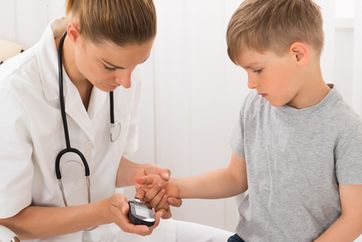Parent-child relationship key to reaching HbA1c goals in pediatric type 1 diabetes
Children with type 1 diabetes are less likely to maintain recommended HbA1c targets if they frequently experience turmoil with their parents and other family members, according to findings published in Diabetic Medicine.
“The association between diabetes-related family conflict and poor glycemic control regardless of insulin regimen supports the importance of screening for and addressing family conflict in all children with type 1 diabetes,” Lydia Snyder, MD, of the division of endocrinology, diabetes and metabolism at Nemours Children’s Health System in Jacksonville, Florida, and colleagues wrote. “The identification and implementation of effective and practical strategies aimed at expanding social support for children with type 1 diabetes and their families may result in improved glycemic control.”
Snyder and researchers measured HbA1c in 1,095 children (mean age, 14.4 years; 51.6% girls) with type 1 diabetes who participated in the SEARCH study. They also assessed family conflict, fear of hypoglycemia, eating disorders and impediments to medical care with surveys that were completed by either the child, a parent or both. These surveys also identified each child’s insulin delivery method, including insulin pump, basal-bolus injection and mixed-insulin regimen.
The researchers reported that 35.8% of the cohort had “poor” glycemic management with an HbA1c of 9.5% or higher. More than half of those who used a mixed-insulin regimen fell into this category (51.2%), and the rates among basal-bolus users and insulin pump users were 45.2% and 28.5%, respectively.
Researchers observed an increased likelihood of poor glycemic management for children on mixed-insulin therapy (OR = 1.1; 95% CI, 1.03-1.22), basal-bolus therapy (OR = 1.2; 95% CI, 1.1-1.35) and insulin pump (OR = 1.1; 95% CI, 1.05-1.15) for each 1-point score increase on the Diabetes Family Conflict Scale.

“The present study supports the findings of previous studies and highlights the significant association of diabetes-related family conflict with poor glycemic control regardless of type of insulin regimen,” the researchers wrote. “It is important that the medical team identify this conflict so that it can be addressed.”
Poor glycemic control was twice as likely for a child using an insulin pump who was on Medicaid or Medicare compared with a child who was on a private insurance plan (adjusted OR = 2; 95% CI, 1.19-3.38). In addition, the researchers observed that nonwhite children using insulin pumps were 2.7 times as likely to have an HbA1c level of more than 9.5% compared with white children (aOR = 2.7; 95% CI, 1.5-4.72).
For insulin pump users, living in multiple households made it 1.8 times more likely that a child would have poor glycemic control compared with a child who said they lived in one home (aOR = 1.8; 95% CI, 1.05-3.08), and the odds were quadrupled for children who skipped their insulin once a week or more compared with those who never missed insulin doses (aOR = 4; 95% CI, 2.4-6.75). Similarly, mixed-insulin users were 4.8 times as likely to have such an elevated level of HbA1c if they lived in multiple households compared with those who lived in one home (aOR = 4.8; 95% CI, 1.21-19.27). The researchers also wrote that children using mixed insulin were 3.8 times more likely to have a higher HbA1c if they had trouble consistently seeing a health care professional vs. those who did not report such issues (aOR = 3.8; 95% CI, 1.47-9.64).
“Targeted efforts to improve diabetes care in this high-risk population may include increased time with the diabetes provider, social worker and the certified diabetes educator,” the researchers wrote. – by Phil Neuffer
Disclosures: The authors report no relevant financial disclosures.
